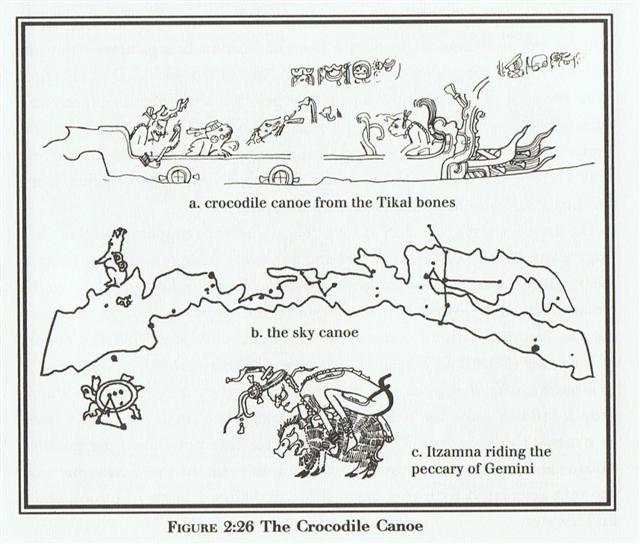393. Side a on the C tablet carries 392 glyphs, but should we count also with a zero place at the beginning the number of days will be 393. ... According to my interpretation the Explorers stayed for 27 days in Oromanga - from DECEMBER 31 (365) to JANUARY 26 (391) - and then they stayed for 5 days in Papa O Pea, i.e. from JANUARY 26 (391) to day 396 = JANUARY 31. Then they went from Papa O Pea in FEBRUARY 1 (32). Although Manuscript E was referring to "August 26 (238) = AUGUST 3 (215 = 238 - 23) = 182 + 33 (FEBRUARY 2) it could be argued that number 237 (= 8 * 29˝ + 1) was a day zero and that therefore the Explorers would take their first step away from the day-time place of Oromanga only when time in the darkness had been completely measured out in full for a night. Time in the night runs like water, sand (or treacle) - whereas the days in the light from the Sun instead fly by quickly.
... Time flows and not until its first measure has been completed in full can there be 1 notched into the wood ... ... In north Asia the common mode of reckoning is in half-year, which are not to be regarded as such but form each one separately the highest unit of time: our informants term them 'winter year' and 'summer year'. Among the Tunguses the former comprises 6˝ months, the latter 5, but the year is said to have 13 months; in Kamchatka each contains six months, the winter year beginning in November, the summer year in May; the Gilyaks on the other hand give five months to summer and seven to winter. The Yeneseisk Ostiaks reckon and name only the seven winter months, and not the summer months. This mode of reckoning seems to be a peculiarity of the far north: the Icelanders reckoned in misseri, half-years, not in whole years, and the rune-staves divide the year into a summer and a winter half, beginning on April 14 [4-14] and October 14 respectively. But in Germany too, when it was desired to denote the whole year, the combined phrase 'winter and summer' was employed, or else equivalent concrete expressions such as 'in bareness and in leaf', 'in straw and in grass' ... ... Among the Nahyssan of S. Carolina time was measured and a rude chronology arranged by means of strings of leather with knots of various colour, like the Peruvian quipos. The Dakota use a circle as the symbol of time, a smaller one for a year and a larger one for a longer period: the circles are arranged in rows, thus: OOO or O-O-O. The Pima of Arizona make use of a tally. The year-mark is a deep notch across the stick ... The Mayan haab year (with 365 days) has 20 days in a month (excepting the last one which has only 5) and the first day in such a month is denoted with day number 0 together by a name for the month. However, the first days in 13-day periods of their tzolkin cycles (with 260 days) are denoted with number 1 (and the name for the period). This indicates the Sun days could have been perceived as not flowing ('dry and firm') in contrast to the nights. 393 (Debeb Cygni, *313.5) - 282 (Spica, *202.7) = 111 (Hamal, *30.5). ... At the time of the loading of the emigrant canoe, Hotu Matua ordered his assistant Teke to take a (stone) figure (moai) named Oto Uta [probably Hamal] on board the canoe, along with the people (aniva) who were emigrating. However, the figure was 'left behind out in the bay' (E:73) Here might be the reason why Gregory XIII insisted upon spring equinox to be at day 80 (instead of at the astronomically more correct day 79). Because seemingly as if by a miracle *313.5 - *202.7 = *110.8 (111):
The Pope eliminated 10 days beginning at Thuban and notably there were also 10 days from Spica (*202) to Thuban (*212):
Spica was the star in the center (Ana-roto). But that was before Thuban ascended. We can see from the diagram below that when the right ascension line between Spica and Alcor (close to Mizar, ζ Ursae Majoris) was at the border around the polar region, around 26000 / 2 years ago, then the very bright (0.03) Vega had been the star at the pole:
... Proclus informs us that the fox star nibbles continuously at the thong of the yoke which holds together heaven and earth; German folklore adds that when the fox succeeds, the world will come to its end. This fox [Vulpecula] star is no other than Alcor, the small star g near zeta Ursae Majoris (in India Arundati, the common wife of the Seven Rishis, alpha-eta Ursae) ... Spica is not visible in the diagram, but that does not matter because we are not dealing with individual stars but with the lines between them.
"[Vulpecula] ... a modern constellation, crowded in by Hevelius to occupy a space between the Arrow and the Swan, where Via Lactea divides into two branches. For this purpose he ransacked the informes of this bifurcation, and was so satisfied with the result, that the effigies figure in the elaborate print of his offerings to Urania. He selected it on account of the Eagle, Cerberus and Vultur Cadens. 'I wished,' said he, 'to place a fox and a goose in the space of the sky well fitted to it; because such an animal is very cunning, voracious and fierce. Aquila and Vultur are of the same nature, rapacious and greedy ..." In the Mayan description above the Milky Way is summarized from the Swan at right to Orion and Gemini at left, with Cassiopeia in the center. Their sky canoe (Milky Way) does not include the sunken ship Argo Navis:
|
||||||||||||||||||||||||||||||||||||||||||||||||||||||||||||||||||||||||||||||||||||||||||||||||||||||||||||||||||||||||||||||||||||||||||||||||||||||||||


















.jpg)
.jpg)